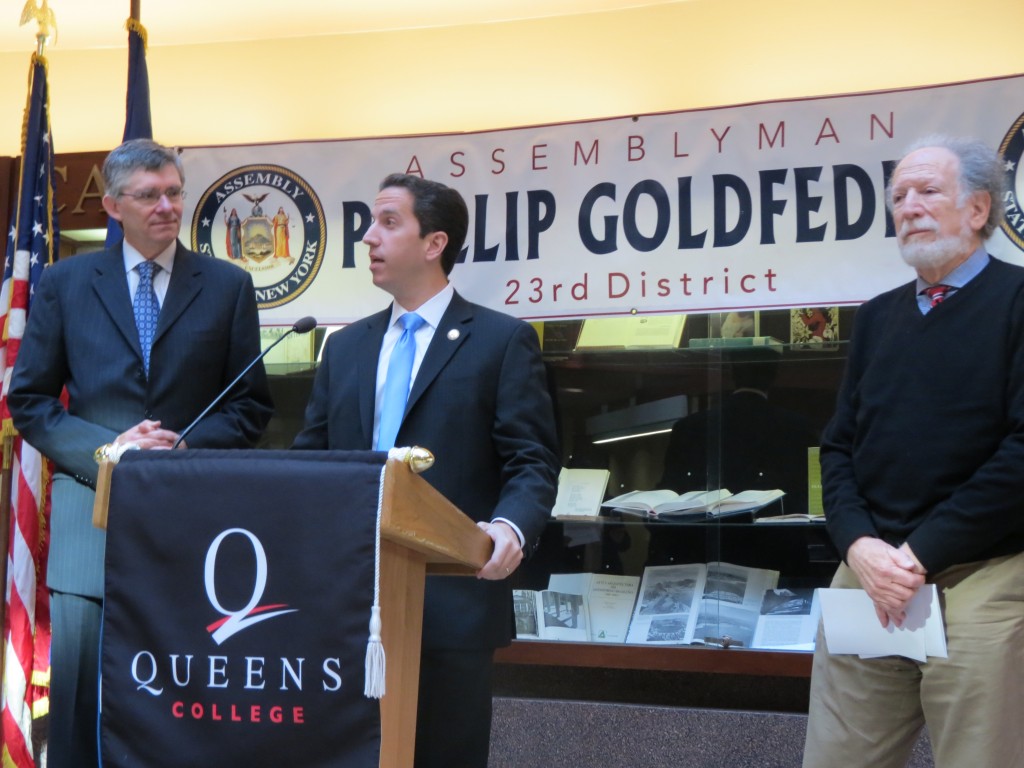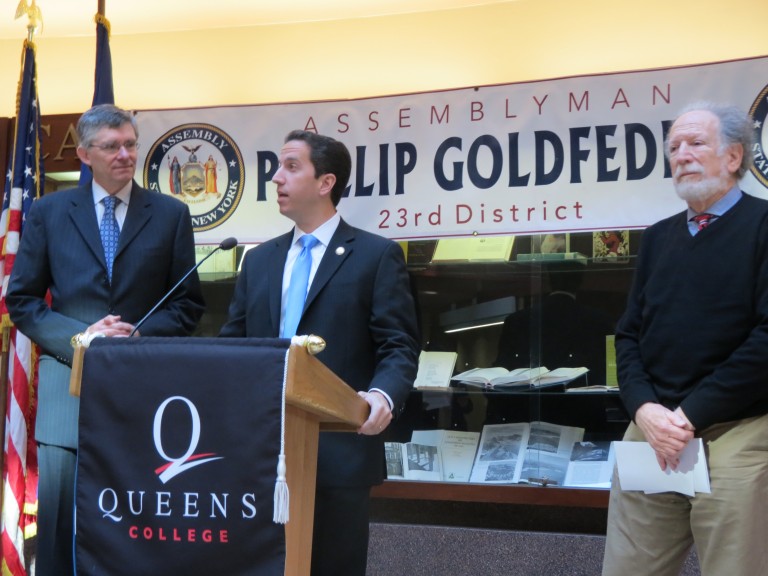
Former Queens College President James Muyskens, left, Assemblyman Phil Goldfeder, and the college’s Department of Urban Studies Chairman Leonard Rodberg announced in November that the college will launch a study on proposals for the abandoned Rockaway Beach Rail Line. Photo by Anna Gustafson
Proposals for the abandoned Rockaway Beach Rail Line, including reactivating the train service and turning the space into a park similar to Manhattan’s High Line, is about to land further scrutiny in a study that the Queens College Department of Urban Studies is set to launch.
The study, initiated by Assemblyman Phil Goldfeder (D-Rockaway Park), will begin by students in the department distributing survey questionnaires about the potential impacts of the various proposed redevelopment options for the rail line, which once ran from Rockaway to Rego Park before being abandoned about 50 years ago.
“While some groups are assessing the feasibility of the rail line using tax dollars and expensive consultants that will only result in one-sided studies, we are utilizing local expert resources and educating our students, all while supporting an objective study that will enormously benefit every Queens family,” Goldfeder said in reference to a $467,000 study, funded by the state, of solely the proposal to turn the space into a park called the QueensWay.
When Queens College and Goldfeder originally announced the study last November, college representatives stressed that the study would look at various proposals, including reactivating the line and the QueensWay. Other residents, particularly Woodhaven residents living on 98th Street, have been opposed to both proposals, saying any kind of development would pose security concerns and decrease property values.
“We will look at them all – and look at them objectively,” Leonard Rodberg, chair of the Department of Urban Studies, said in November of the proposals.
The study will be primarily overseen by Scott Larson, a lecturer in the Department of Urban Studies, who said students will look at existing data, including U.S. Census numbers, as well as gather new data to assess the proposals. Once the study is completed, the results will be made available to the public.
The questionnaires will be hand delivered to 5,000 residents and 1,000 businesses along the path of the abandoned rail line, as well as in Howard Beach and the Rockaways. Respondents have the choice of submitting the completed questionnaires using self-addressed, postage-paid envelopes or going online to a web addresses printed on the questionnaire.
“The Queens Public Transit Committee strongly encourages everyone who receives this important survey to please fill it out,” said Phil McManus, a Rockaway resident and founder of the Queens Public Transit Committee. “We believe all the people of Queens should be heard, and we should have the same transit opportunities and benefits of our Manhattan neighbors.
“This survey is just the beginning of informing and organizing the people to demand faster transportation, including the Queens Rockaway Beach Line – the new Queens Crosstown,” McManus continued.
Larson too stressed the importance of people taking the questionnaire seriously.
“Our hope is to gather a representative sample from all the communities likely to be impacted by any redevelopment, and to contribute to conversations about the potential benefits and possible negative impacts of each development option.”
The collaborative study will include assessments of community transportation patterns and needs, as well as community attitudes about the impacts, costs, need for and feasibility of a range of proposed uses of the abandoned line.
The Rockaway Beach Rail Line, also known as the White Pot Junction Line, was created around the turn of the 20th century and was owned and operated by the Long Island Rail Road. A trip on the line from Rockaway to Manhattan took about 40 minutes – which residents have noted is far faster than the same trip takes now.
Both supporters of the QueensWay and reactivating the line have said their respective proposals would benefit residents throughout the borough. Park proponents often argue residents’ quality of life would be boosted by the green space, while those who want the line restored have said it would bring crucial economic development to South Queens and Rockaway – areas that are underserved by mass transportation.
By Anna Gustafson

